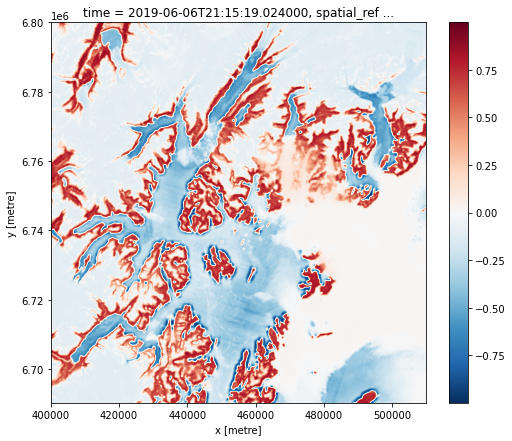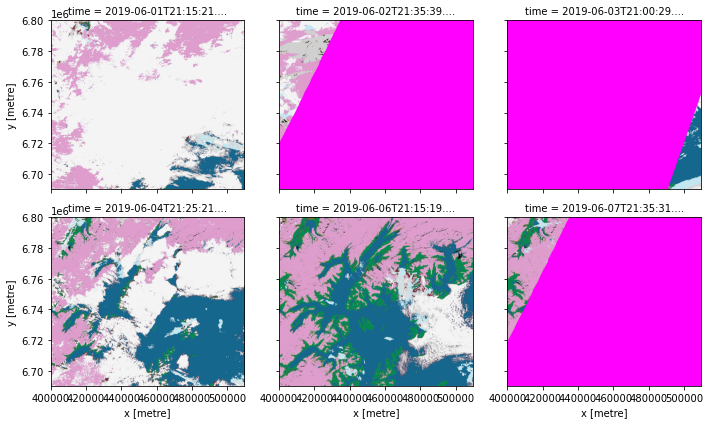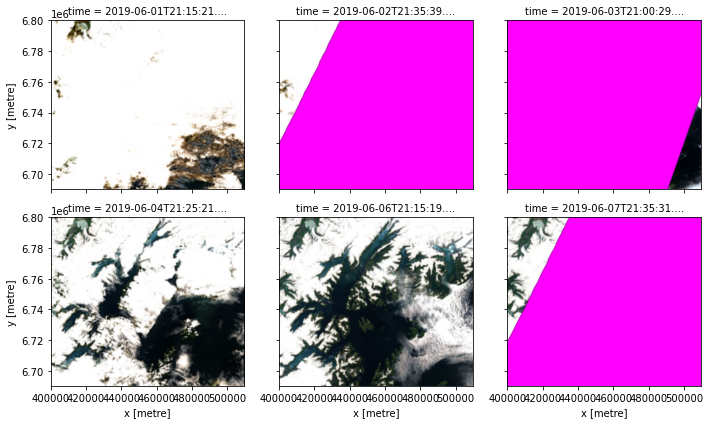Access Sentinel 2 Data on Planetary Computer¶
Setup Instructions¶
This notebook is meant to run on Planetary Computer lab hub.
We need to install extra libraries first:
pip install 'odc-stac>=0.2.0a9'
This is enough to load data. But this notebook also uses some extra utilities from
pip install odc-algo odc-ui
[1]:
#!pip install odc-stac>=0.2.0a9
#!pip install odc-ui odc-algo
[2]:
import numpy as np
import planetary_computer as pc
import yaml
from dask.distributed import wait as dask_wait
from IPython.display import display
from pystac_client import Client
from odc.stac import stac_load
Configuration¶
For now we need to manually supply band dtype and nodata information for each band in the collection. Use band named * as a wildcard.
[3]:
cfg = """---
"*":
warnings: ignore # Disable warnings about duplicate common names
sentinel-2-l2a:
assets:
'*':
data_type: uint16
nodata: 0
unit: '1'
SCL:
data_type: uint8
nodata: 0
unit: '1'
visual:
data_type: uint8
nodata: 0
unit: '1'
aliases: # Alias -> Canonical Name
rededge1: B05 # Work around non-unique `rededge` common name in S2
rededge2: B06 # ..
rededge3: B07 # ..
"""
cfg = yaml.load(cfg, Loader=yaml.CSafeLoader)
Start Dask Client¶
This step is optional, but it does improve load speed significantly. You don’t have to use Dask, as you can load data directly into memory of the notebook.
[4]:
from datacube.utils.dask import start_local_dask
client = start_local_dask()
Query STAC API¶
Here we are looking for datasets in sentinel-2-l2a collection from June 2019 over MGRS tile 06VVN.
[5]:
catalog = Client.open("https://planetarycomputer.microsoft.com/api/stac/v1")
query = catalog.search(
collections=["sentinel-2-l2a"],
datetime="2019-06",
query={"s2:mgrs_tile": dict(eq="06VVN")},
)
items = list(query.get_items())
print(f"Found: {len(items):d} datasets")
Found: 23 datasets
Lazy load all the bands¶
We won’t use all the bands but it doesn’t matter as bands that we won’t use won’t be loaded. We are “loading” data with Dask, which means that at this point no reads will be happening just yet.
If you were to skip warnings: ignore in the configuration, you’ll see a warning about rededge common name being used on several bands. Basically we can only work with common names that uniquely identify some band. In this case EO extension defines common name rededge for bands 5, 6 and 7.
[6]:
SHRINK = 4
resolution = 10
if SHRINK > 1:
resolution = resolution * SHRINK
xx = stac_load(
items,
chunks={"x": 2048, "y": 2048},
stac_cfg=cfg,
patch_url=pc.sign,
resolution=resolution,
)
print(f"Bands: {','.join(list(xx.data_vars))}")
display(xx)
Bands: AOT,B01,B02,B03,B04,B05,B06,B07,B08,B09,B11,B12,B8A,SCL,WVP,visual
<xarray.Dataset>
Dimensions: (time: 23, y: 2745, x: 2745)
Coordinates:
* time (time) datetime64[ns] 2019-06-01T21:15:21.024000 ... 2019-06...
* y (y) float64 6.8e+06 6.8e+06 6.8e+06 ... 6.69e+06 6.69e+06
* x (x) float64 4e+05 4e+05 4.001e+05 ... 5.097e+05 5.097e+05
spatial_ref int32 32606
Data variables: (12/16)
AOT (time, y, x) uint16 dask.array<chunksize=(1, 2048, 2048), meta=np.ndarray>
B01 (time, y, x) uint16 dask.array<chunksize=(1, 2048, 2048), meta=np.ndarray>
B02 (time, y, x) uint16 dask.array<chunksize=(1, 2048, 2048), meta=np.ndarray>
B03 (time, y, x) uint16 dask.array<chunksize=(1, 2048, 2048), meta=np.ndarray>
B04 (time, y, x) uint16 dask.array<chunksize=(1, 2048, 2048), meta=np.ndarray>
B05 (time, y, x) uint16 dask.array<chunksize=(1, 2048, 2048), meta=np.ndarray>
... ...
B11 (time, y, x) uint16 dask.array<chunksize=(1, 2048, 2048), meta=np.ndarray>
B12 (time, y, x) uint16 dask.array<chunksize=(1, 2048, 2048), meta=np.ndarray>
B8A (time, y, x) uint16 dask.array<chunksize=(1, 2048, 2048), meta=np.ndarray>
SCL (time, y, x) uint8 dask.array<chunksize=(1, 2048, 2048), meta=np.ndarray>
WVP (time, y, x) uint16 dask.array<chunksize=(1, 2048, 2048), meta=np.ndarray>
visual (time, y, x) uint8 dask.array<chunksize=(1, 2048, 2048), meta=np.ndarray>
Attributes:
crs: EPSG:32606
grid_mapping: spatial_ref- time: 23
- y: 2745
- x: 2745
- time(time)datetime64[ns]2019-06-01T21:15:21.024000 ... 2...
- units :
- seconds since 1970-01-01 00:00:00
array(['2019-06-01T21:15:21.024000000', '2019-06-02T21:35:39.024000000', '2019-06-03T21:00:29.024000000', '2019-06-04T21:25:21.024000000', '2019-06-06T21:15:19.024000000', '2019-06-07T21:35:31.024000000', '2019-06-08T21:00:21.024000000', '2019-06-09T21:25:29.024000000', '2019-06-11T21:15:21.024000000', '2019-06-12T21:35:39.024000000', '2019-06-13T21:00:29.024000000', '2019-06-14T21:25:31.024000000', '2019-06-16T21:15:19.024000000', '2019-06-17T21:35:31.024000000', '2019-06-18T21:00:31.024000000', '2019-06-19T21:25:29.024000000', '2019-06-21T21:15:21.024000000', '2019-06-23T21:00:29.024000000', '2019-06-24T21:25:31.024000000', '2019-06-26T21:15:19.024000000', '2019-06-27T21:35:31.024000000', '2019-06-28T21:00:31.024000000', '2019-06-29T21:25:29.024000000'], dtype='datetime64[ns]') - y(y)float646.8e+06 6.8e+06 ... 6.69e+06
- units :
- metre
- resolution :
- -40.0
- crs :
- EPSG:32606
array([6800020., 6799980., 6799940., ..., 6690340., 6690300., 6690260.])
- x(x)float644e+05 4e+05 ... 5.097e+05 5.097e+05
- units :
- metre
- resolution :
- 40.0
- crs :
- EPSG:32606
array([399980., 400020., 400060., ..., 509660., 509700., 509740.])
- spatial_ref()int3232606
- spatial_ref :
- PROJCS["WGS 84 / UTM zone 6N",GEOGCS["WGS 84",DATUM["WGS_1984",SPHEROID["WGS 84",6378137,298.257223563,AUTHORITY["EPSG","7030"]],AUTHORITY["EPSG","6326"]],PRIMEM["Greenwich",0,AUTHORITY["EPSG","8901"]],UNIT["degree",0.0174532925199433,AUTHORITY["EPSG","9122"]],AUTHORITY["EPSG","4326"]],PROJECTION["Transverse_Mercator"],PARAMETER["latitude_of_origin",0],PARAMETER["central_meridian",-147],PARAMETER["scale_factor",0.9996],PARAMETER["false_easting",500000],PARAMETER["false_northing",0],UNIT["metre",1,AUTHORITY["EPSG","9001"]],AXIS["Easting",EAST],AXIS["Northing",NORTH],AUTHORITY["EPSG","32606"]]
- grid_mapping_name :
- transverse_mercator
array(32606, dtype=int32)
- AOT(time, y, x)uint16dask.array<chunksize=(1, 2048, 2048), meta=np.ndarray>
- nodata :
- 0
- units :
- 1
- crs :
- EPSG:32606
- grid_mapping :
- spatial_ref
Array Chunk Bytes 330.55 MiB 8.00 MiB Shape (23, 2745, 2745) (1, 2048, 2048) Count 115 Tasks 92 Chunks Type uint16 numpy.ndarray - B01(time, y, x)uint16dask.array<chunksize=(1, 2048, 2048), meta=np.ndarray>
- nodata :
- 0
- units :
- 1
- crs :
- EPSG:32606
- grid_mapping :
- spatial_ref
Array Chunk Bytes 330.55 MiB 8.00 MiB Shape (23, 2745, 2745) (1, 2048, 2048) Count 115 Tasks 92 Chunks Type uint16 numpy.ndarray - B02(time, y, x)uint16dask.array<chunksize=(1, 2048, 2048), meta=np.ndarray>
- nodata :
- 0
- units :
- 1
- crs :
- EPSG:32606
- grid_mapping :
- spatial_ref
Array Chunk Bytes 330.55 MiB 8.00 MiB Shape (23, 2745, 2745) (1, 2048, 2048) Count 115 Tasks 92 Chunks Type uint16 numpy.ndarray - B03(time, y, x)uint16dask.array<chunksize=(1, 2048, 2048), meta=np.ndarray>
- nodata :
- 0
- units :
- 1
- crs :
- EPSG:32606
- grid_mapping :
- spatial_ref
Array Chunk Bytes 330.55 MiB 8.00 MiB Shape (23, 2745, 2745) (1, 2048, 2048) Count 115 Tasks 92 Chunks Type uint16 numpy.ndarray - B04(time, y, x)uint16dask.array<chunksize=(1, 2048, 2048), meta=np.ndarray>
- nodata :
- 0
- units :
- 1
- crs :
- EPSG:32606
- grid_mapping :
- spatial_ref
Array Chunk Bytes 330.55 MiB 8.00 MiB Shape (23, 2745, 2745) (1, 2048, 2048) Count 115 Tasks 92 Chunks Type uint16 numpy.ndarray - B05(time, y, x)uint16dask.array<chunksize=(1, 2048, 2048), meta=np.ndarray>
- nodata :
- 0
- units :
- 1
- crs :
- EPSG:32606
- grid_mapping :
- spatial_ref
Array Chunk Bytes 330.55 MiB 8.00 MiB Shape (23, 2745, 2745) (1, 2048, 2048) Count 115 Tasks 92 Chunks Type uint16 numpy.ndarray - B06(time, y, x)uint16dask.array<chunksize=(1, 2048, 2048), meta=np.ndarray>
- nodata :
- 0
- units :
- 1
- crs :
- EPSG:32606
- grid_mapping :
- spatial_ref
Array Chunk Bytes 330.55 MiB 8.00 MiB Shape (23, 2745, 2745) (1, 2048, 2048) Count 115 Tasks 92 Chunks Type uint16 numpy.ndarray - B07(time, y, x)uint16dask.array<chunksize=(1, 2048, 2048), meta=np.ndarray>
- nodata :
- 0
- units :
- 1
- crs :
- EPSG:32606
- grid_mapping :
- spatial_ref
Array Chunk Bytes 330.55 MiB 8.00 MiB Shape (23, 2745, 2745) (1, 2048, 2048) Count 115 Tasks 92 Chunks Type uint16 numpy.ndarray - B08(time, y, x)uint16dask.array<chunksize=(1, 2048, 2048), meta=np.ndarray>
- nodata :
- 0
- units :
- 1
- crs :
- EPSG:32606
- grid_mapping :
- spatial_ref
Array Chunk Bytes 330.55 MiB 8.00 MiB Shape (23, 2745, 2745) (1, 2048, 2048) Count 115 Tasks 92 Chunks Type uint16 numpy.ndarray - B09(time, y, x)uint16dask.array<chunksize=(1, 2048, 2048), meta=np.ndarray>
- nodata :
- 0
- units :
- 1
- crs :
- EPSG:32606
- grid_mapping :
- spatial_ref
Array Chunk Bytes 330.55 MiB 8.00 MiB Shape (23, 2745, 2745) (1, 2048, 2048) Count 115 Tasks 92 Chunks Type uint16 numpy.ndarray - B11(time, y, x)uint16dask.array<chunksize=(1, 2048, 2048), meta=np.ndarray>
- nodata :
- 0
- units :
- 1
- crs :
- EPSG:32606
- grid_mapping :
- spatial_ref
Array Chunk Bytes 330.55 MiB 8.00 MiB Shape (23, 2745, 2745) (1, 2048, 2048) Count 115 Tasks 92 Chunks Type uint16 numpy.ndarray - B12(time, y, x)uint16dask.array<chunksize=(1, 2048, 2048), meta=np.ndarray>
- nodata :
- 0
- units :
- 1
- crs :
- EPSG:32606
- grid_mapping :
- spatial_ref
Array Chunk Bytes 330.55 MiB 8.00 MiB Shape (23, 2745, 2745) (1, 2048, 2048) Count 115 Tasks 92 Chunks Type uint16 numpy.ndarray - B8A(time, y, x)uint16dask.array<chunksize=(1, 2048, 2048), meta=np.ndarray>
- nodata :
- 0
- units :
- 1
- crs :
- EPSG:32606
- grid_mapping :
- spatial_ref
Array Chunk Bytes 330.55 MiB 8.00 MiB Shape (23, 2745, 2745) (1, 2048, 2048) Count 115 Tasks 92 Chunks Type uint16 numpy.ndarray - SCL(time, y, x)uint8dask.array<chunksize=(1, 2048, 2048), meta=np.ndarray>
- nodata :
- 0
- units :
- 1
- crs :
- EPSG:32606
- grid_mapping :
- spatial_ref
Array Chunk Bytes 165.28 MiB 4.00 MiB Shape (23, 2745, 2745) (1, 2048, 2048) Count 115 Tasks 92 Chunks Type uint8 numpy.ndarray - WVP(time, y, x)uint16dask.array<chunksize=(1, 2048, 2048), meta=np.ndarray>
- nodata :
- 0
- units :
- 1
- crs :
- EPSG:32606
- grid_mapping :
- spatial_ref
Array Chunk Bytes 330.55 MiB 8.00 MiB Shape (23, 2745, 2745) (1, 2048, 2048) Count 115 Tasks 92 Chunks Type uint16 numpy.ndarray - visual(time, y, x)uint8dask.array<chunksize=(1, 2048, 2048), meta=np.ndarray>
- nodata :
- 0
- units :
- 1
- crs :
- EPSG:32606
- grid_mapping :
- spatial_ref
Array Chunk Bytes 165.28 MiB 4.00 MiB Shape (23, 2745, 2745) (1, 2048, 2048) Count 115 Tasks 92 Chunks Type uint8 numpy.ndarray
- crs :
- EPSG:32606
- grid_mapping :
- spatial_ref
By default stac_load will return all the data bands using canonical asset names. But we can also request a subset of bands, by supplying bands= parameter. When going this route you can also use “common name” to refer to a band.
In this case we request red,green,blue,nir bands which are common names for bands B04,B03,B02,B08 and SCL band which is a canonical name.
[7]:
xx = stac_load(
items,
bands=["red", "green", "blue", "nir", "SCL"],
resolution=resolution,
chunks={"x": 2048, "y": 2048},
stac_cfg=cfg,
patch_url=pc.sign,
)
print(f"Bands: {','.join(list(xx.data_vars))}")
display(xx)
Bands: red,green,blue,nir,SCL
<xarray.Dataset>
Dimensions: (time: 23, y: 2745, x: 2745)
Coordinates:
* time (time) datetime64[ns] 2019-06-01T21:15:21.024000 ... 2019-06...
* y (y) float64 6.8e+06 6.8e+06 6.8e+06 ... 6.69e+06 6.69e+06
* x (x) float64 4e+05 4e+05 4.001e+05 ... 5.097e+05 5.097e+05
spatial_ref int32 32606
Data variables:
red (time, y, x) uint16 dask.array<chunksize=(1, 2048, 2048), meta=np.ndarray>
green (time, y, x) uint16 dask.array<chunksize=(1, 2048, 2048), meta=np.ndarray>
blue (time, y, x) uint16 dask.array<chunksize=(1, 2048, 2048), meta=np.ndarray>
nir (time, y, x) uint16 dask.array<chunksize=(1, 2048, 2048), meta=np.ndarray>
SCL (time, y, x) uint8 dask.array<chunksize=(1, 2048, 2048), meta=np.ndarray>
Attributes:
crs: EPSG:32606
grid_mapping: spatial_ref- time: 23
- y: 2745
- x: 2745
- time(time)datetime64[ns]2019-06-01T21:15:21.024000 ... 2...
- units :
- seconds since 1970-01-01 00:00:00
array(['2019-06-01T21:15:21.024000000', '2019-06-02T21:35:39.024000000', '2019-06-03T21:00:29.024000000', '2019-06-04T21:25:21.024000000', '2019-06-06T21:15:19.024000000', '2019-06-07T21:35:31.024000000', '2019-06-08T21:00:21.024000000', '2019-06-09T21:25:29.024000000', '2019-06-11T21:15:21.024000000', '2019-06-12T21:35:39.024000000', '2019-06-13T21:00:29.024000000', '2019-06-14T21:25:31.024000000', '2019-06-16T21:15:19.024000000', '2019-06-17T21:35:31.024000000', '2019-06-18T21:00:31.024000000', '2019-06-19T21:25:29.024000000', '2019-06-21T21:15:21.024000000', '2019-06-23T21:00:29.024000000', '2019-06-24T21:25:31.024000000', '2019-06-26T21:15:19.024000000', '2019-06-27T21:35:31.024000000', '2019-06-28T21:00:31.024000000', '2019-06-29T21:25:29.024000000'], dtype='datetime64[ns]') - y(y)float646.8e+06 6.8e+06 ... 6.69e+06
- units :
- metre
- resolution :
- -40.0
- crs :
- EPSG:32606
array([6800020., 6799980., 6799940., ..., 6690340., 6690300., 6690260.])
- x(x)float644e+05 4e+05 ... 5.097e+05 5.097e+05
- units :
- metre
- resolution :
- 40.0
- crs :
- EPSG:32606
array([399980., 400020., 400060., ..., 509660., 509700., 509740.])
- spatial_ref()int3232606
- spatial_ref :
- PROJCS["WGS 84 / UTM zone 6N",GEOGCS["WGS 84",DATUM["WGS_1984",SPHEROID["WGS 84",6378137,298.257223563,AUTHORITY["EPSG","7030"]],AUTHORITY["EPSG","6326"]],PRIMEM["Greenwich",0,AUTHORITY["EPSG","8901"]],UNIT["degree",0.0174532925199433,AUTHORITY["EPSG","9122"]],AUTHORITY["EPSG","4326"]],PROJECTION["Transverse_Mercator"],PARAMETER["latitude_of_origin",0],PARAMETER["central_meridian",-147],PARAMETER["scale_factor",0.9996],PARAMETER["false_easting",500000],PARAMETER["false_northing",0],UNIT["metre",1,AUTHORITY["EPSG","9001"]],AXIS["Easting",EAST],AXIS["Northing",NORTH],AUTHORITY["EPSG","32606"]]
- grid_mapping_name :
- transverse_mercator
array(32606, dtype=int32)
- red(time, y, x)uint16dask.array<chunksize=(1, 2048, 2048), meta=np.ndarray>
- nodata :
- 0
- units :
- 1
- crs :
- EPSG:32606
- grid_mapping :
- spatial_ref
Array Chunk Bytes 330.55 MiB 8.00 MiB Shape (23, 2745, 2745) (1, 2048, 2048) Count 115 Tasks 92 Chunks Type uint16 numpy.ndarray - green(time, y, x)uint16dask.array<chunksize=(1, 2048, 2048), meta=np.ndarray>
- nodata :
- 0
- units :
- 1
- crs :
- EPSG:32606
- grid_mapping :
- spatial_ref
Array Chunk Bytes 330.55 MiB 8.00 MiB Shape (23, 2745, 2745) (1, 2048, 2048) Count 115 Tasks 92 Chunks Type uint16 numpy.ndarray - blue(time, y, x)uint16dask.array<chunksize=(1, 2048, 2048), meta=np.ndarray>
- nodata :
- 0
- units :
- 1
- crs :
- EPSG:32606
- grid_mapping :
- spatial_ref
Array Chunk Bytes 330.55 MiB 8.00 MiB Shape (23, 2745, 2745) (1, 2048, 2048) Count 115 Tasks 92 Chunks Type uint16 numpy.ndarray - nir(time, y, x)uint16dask.array<chunksize=(1, 2048, 2048), meta=np.ndarray>
- nodata :
- 0
- units :
- 1
- crs :
- EPSG:32606
- grid_mapping :
- spatial_ref
Array Chunk Bytes 330.55 MiB 8.00 MiB Shape (23, 2745, 2745) (1, 2048, 2048) Count 115 Tasks 92 Chunks Type uint16 numpy.ndarray - SCL(time, y, x)uint8dask.array<chunksize=(1, 2048, 2048), meta=np.ndarray>
- nodata :
- 0
- units :
- 1
- crs :
- EPSG:32606
- grid_mapping :
- spatial_ref
Array Chunk Bytes 165.28 MiB 4.00 MiB Shape (23, 2745, 2745) (1, 2048, 2048) Count 115 Tasks 92 Chunks Type uint8 numpy.ndarray
- crs :
- EPSG:32606
- grid_mapping :
- spatial_ref
Import some tools from odc.{algo,ui}¶
[8]:
import ipywidgets
from datacube.utils.geometry import gbox
from odc.algo import colorize, to_float, to_rgba, xr_reproject
from odc.ui import to_jpeg_data
from odc.ui.plt_tools import scl_colormap
Do some math with bands¶
[9]:
# like .astype(float32) but taking care of nodata->NaN mapping
nir = to_float(xx.nir)
red = to_float(xx.red)
ndvi = (nir - red) / (
nir + red
) # < This is still a lazy Dask computation (no data loaded yet)
# Get the 5-th time slice `load->compute->plot`
_ = ndvi.isel(time=4).compute().plot.imshow(size=7, aspect=1.2, interpolation="bicubic")

For sample purposes work with first 6 observations only
[10]:
xx = xx.isel(time=np.s_[:6])
Generate some RGB images¶
In this case we take SCL band and “colorize” it, simply replace every known category with an RGB pixel. Also we take RGB bands clamp pixel values into [0,255] range and form an RGBA image. Alpha band is set to transparent for those pixels that were nodata in the original uint16 data for any of the channels.
Compute Alpha band using
.nodatapropertyClamp band
.red,.green,.blueto[1, 3000]Scale to
[0,255]Arrange it in a 4 channel image RGBA
In our case bands were named “red,green,blue” and so to_rgba(..) know what band to use for what color, if you have native band names you can use bands= parameter to define which band is red, green and blue:
to_rgba(..., bands=("B04","B03","B02"))
[11]:
scl_rgb = colorize(xx.SCL, scl_colormap)
im_rgba = to_rgba(xx, clamp=(1, 3_000))
Load all the data into Dask Cluster¶
So far we have only constructed Dask graphs of computations we might want to perform. Now we use client.persist(..) to tell Dask to actually start data loading and processing and to keep results in the memory of the Dask cluster. We will then pull results into local process for display as we need it.
[12]:
%%time
scl_rgb, im_rgba = client.persist([scl_rgb, im_rgba])
_ = dask_wait([scl_rgb, im_rgba])
CPU times: user 433 ms, sys: 33.2 ms, total: 466 ms
Wall time: 3.15 s
Plot Imagery¶
If all went well Dask have loaded all the data and transformed raw pixels into RGBA images. We can now visualise results using the same xarray plot tools we could use with local data. Behind the scenes Dask will transfer imagery from the cluster to the notebook as needed, since we used .persist(..) this operation should be quick. Preparing plots does take some time, but it’s mostly the cost of interpolation for display as we need to resize ~10 megapixel images down to small size.
[13]:
scl_rgb.plot.imshow(
col="time", col_wrap=3, size=3, aspect=1, interpolation="antialiased"
)
fig = im_rgba.plot.imshow(
col="time", col_wrap=3, size=3, aspect=1, interpolation="bicubic"
)
for ax in fig.axes.ravel():
ax.set_facecolor("magenta")


Make and display some thumbnails¶
[14]:
# Covers same area as original but only 320x320 pixels in size
thumb_geobox = gbox.zoom_to(xx.geobox, (320, 320))
# Reproject original Data then convert to RGB
rgba_small = to_rgba(
xr_reproject(xx[["red", "green", "blue"]], thumb_geobox, resampling="cubic"),
clamp=(1, 3000),
)
# Same for SCL, but we can only use nearest|mode resampling
scl_small = colorize(
xr_reproject(xx.SCL, thumb_geobox, resampling="mode"), scl_colormap
)
# Compress image 5 (index 4) to JPEG and display
idx = 4
ims = [
ipywidgets.Image(value=to_jpeg_data(rgba_small.isel(time=idx).data.compute(), 80)),
ipywidgets.Image(value=to_jpeg_data(scl_small.isel(time=idx).data.compute(), 80)),
]
display(ipywidgets.HBox(ims))
[15]:
# Change to True to display higher resolution
if False:
display(
ipywidgets.Image(value=to_jpeg_data(im_rgba.isel(time=idx).data.compute(), 90))
)
display(
ipywidgets.Image(value=to_jpeg_data(scl_rgb.isel(time=idx).data.compute(), 90))
)